Review and images by Birdsage; edited by bmathison1972
Here’s my review of one of the most interesting sets from Play Visions’ Habitat: Earth line of animal figures: the “Civets, Genets & Mongoose” collection from 1998. All of these tube-sized models are between 6.5-8.5 cm (~2.5-3.5 in) long and are marked with a number from 1 to 8, ©, PV, 1998, CHINA, and the name of the figure. These are replicas of feliform carnivorans (so evolutionarily closer to cats than to dogs) that were at the time classified in the family Viverridae, which now includes just the civets and genets. Many of the figures in this set are unique species that have never been made as commercially-available toys by any other company. With that said, let’s dive into the figures, ordered by number.
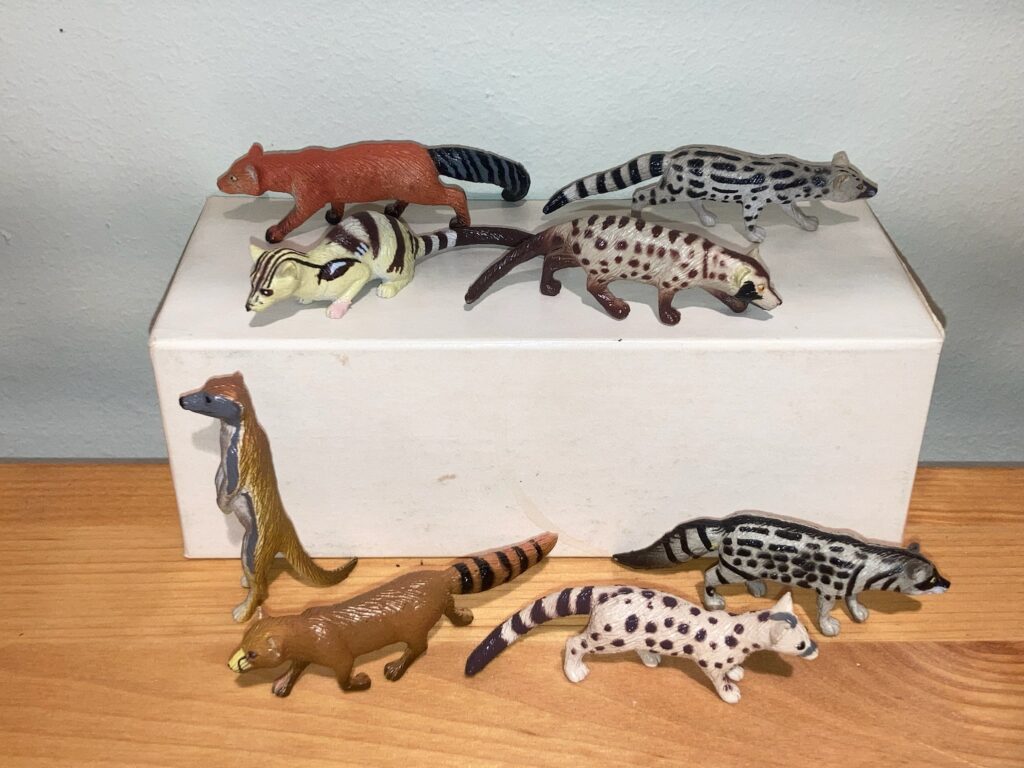
The first figure in this set is the African Civet (Civettictis civetta). This species is notably larger and more terrestrial than most viverrids and feeds on small animals and fruits. Native to the forests and savannas of sub-Saharan Africa, C. civetta is perhaps best known to most as the natural source of the “civet” used in perfumes. This 1:15-1:19 scale replica is definitely not as nice as the prototype version shown below: the black mask should extend to the chin and throat, and the black legs and feet are absent. The light grayish color is kind of strange too. They did make sure to include the unbroken black line on the back and the curved stripes on the neck, and the proportions are good, but the bright yellow eyes are certainly distracting. Fortunately, a CollectA figure representing this species is available that far surpasses this one.

The Banded Palm Civet or simply Banded Civet (Hemigalus derbyanus) is a distinctive species of civet native to Sumatra, Borneo, and peninsular Indochina. This is also a relatively terrestrial species, but it will climb trees. In terms of its diet, it is strictly carnivorous and primarily an invertivore, and does not eat fruit like many other civets do. This 1:11-1:13 toy is a good representation of the animal, featuring the namesake banded pattern, a large pointed head, a striped face, and a mostly brown tail with a banded base. There may be too few bands on the back, and two of the facial stripes could’ve been omitted, but the paintjob is very commendable nonetheless. I like the crouching pose, as it’s not something you see all that often. There is another version of this figure from the Rainforest set that seems to be the figure pictured in the catalog.
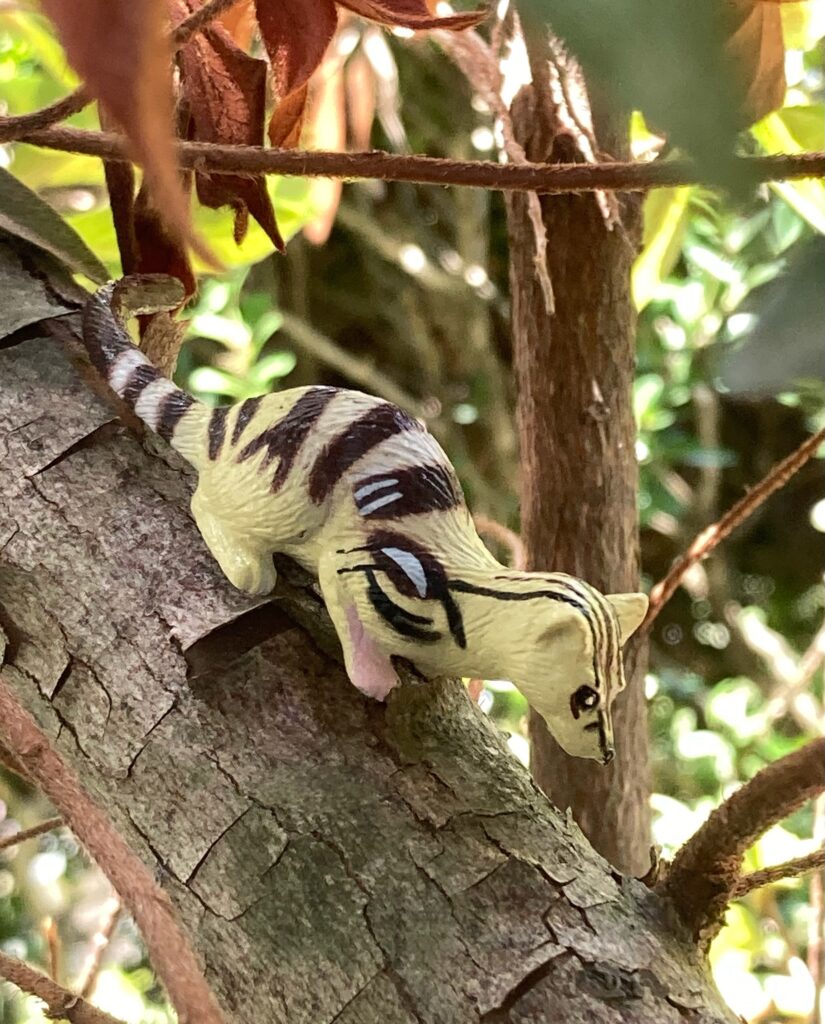
Next is the Ethiopian Genet (Genetta abyssinica), or Abyssinian Genet as the figure is labeled. Not much information is available on this poorly studied carnivore native to the highlands of northeastern Africa. Play Visions’s miniature is a very faithful recreation of G. abyssinica and holds up well even today. It sports a ringed tail and a naturalistic spot pattern, and also features proportionate limbs and an accurately shaped head. While a longer tail with another band or two would’ve been better, that may simply have been prohibited by the small size of the figure. The pose is nothing to sneeze at, and this roughly 1:10 scale figure would pair nicely with Yowie’s Blue-winged-Goose and the Beauty of Beasts Ethiopian Wolf.
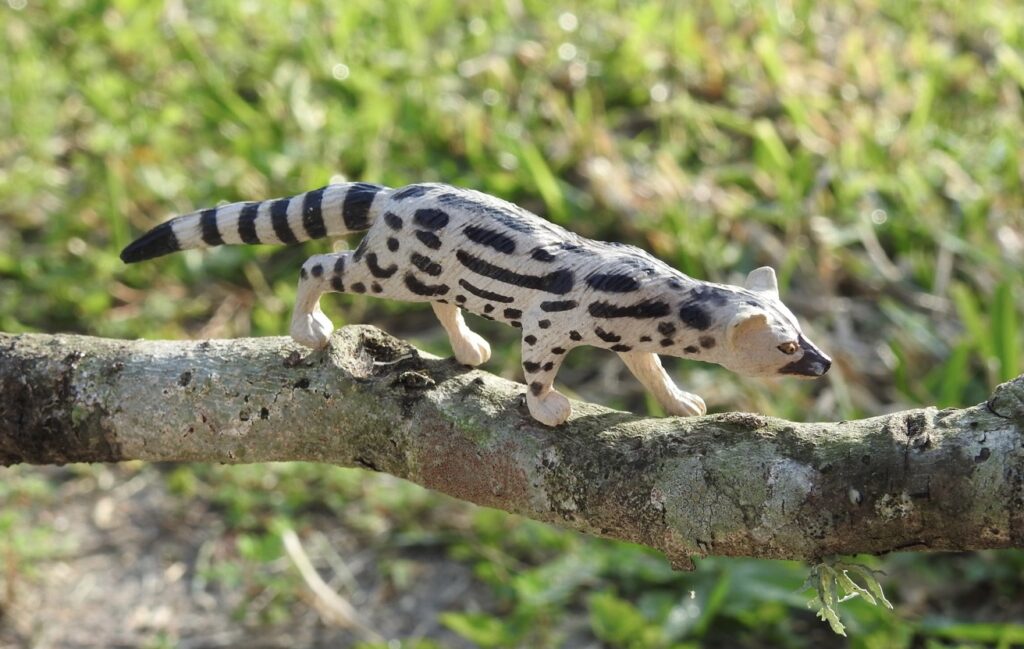
This is the Spotted Linsang (Prionodon pardicolor), a small arboreal predator hailing from the rainforests of mainland Southeast Asia, from South China to Cambodia. Along with its more southerly relative, the Banded Linsang (Prionodon linsang), the Spotted Linsang is now classified in the family Prionodontidae. This is quite a well-done figure, particularly for its size and age. Accurately proportioned and realistically covered in round dark spots that even extend to its neck and forelegs, the only major inaccuracy is that the spots on the neck would merge together into bars in life. Despite that and the relatively unspectacular pose, this replica is very much worth getting. The scale is 1:7-1:8.
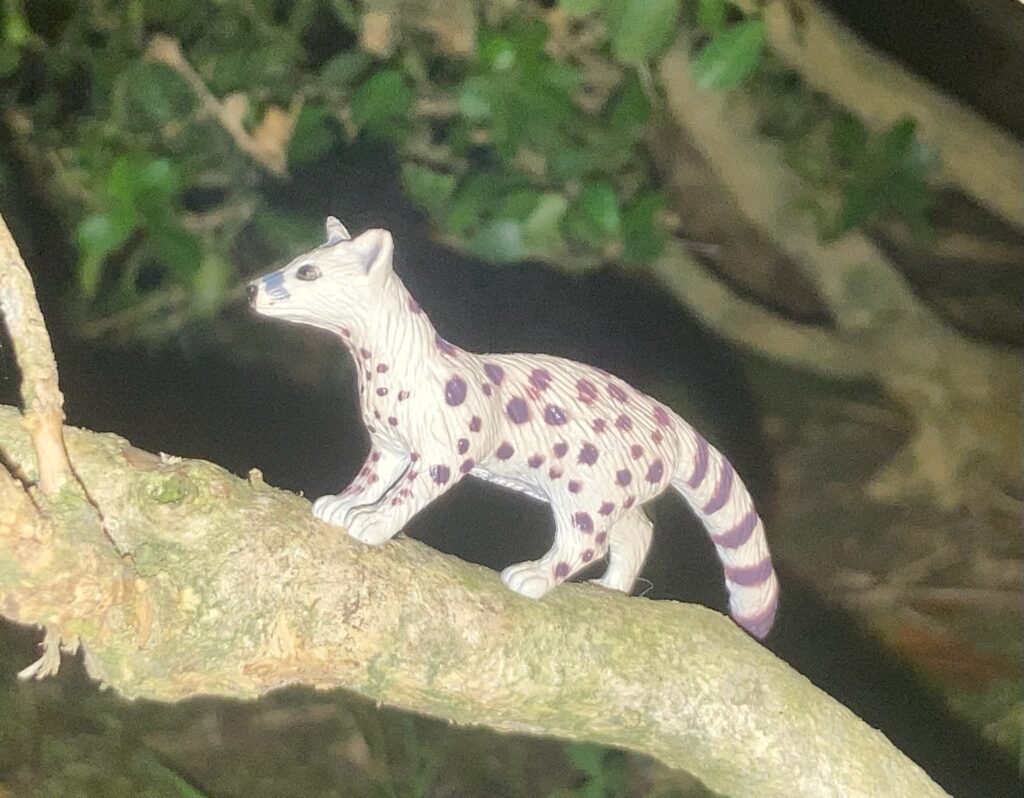
The Aquatic Genet (Genetta piscivora) is a viverrid native to the northeastern DRC. G. piscivora is endemic to the forests and swamps of the northeastern DRC and is considered one of the most elusive and least known carnivorans on the African continent. It is known, however, that its diet consists chiefly of fish, especially catfish, hence its species name. This figure was curiously marked AQUAT CIVET and indeed, at the time of its release, G. piscivora was called a civet, not a genet, and was classified in its own genus, Osbornictis. From the few photos I can find, the animal is mostly reddish in color with lighter underparts, a black tail, and (sometimes) darker-colored feet, and this toy captures this color scheme quite well. This 1:7-1:8 figure is well-proportioned, with a moderately bushy tail and an accurately shaped face. I’m not sure what the banding on the tail is based on, and the white facial pattern is lacking, but this is definitely still a recommendable figure.
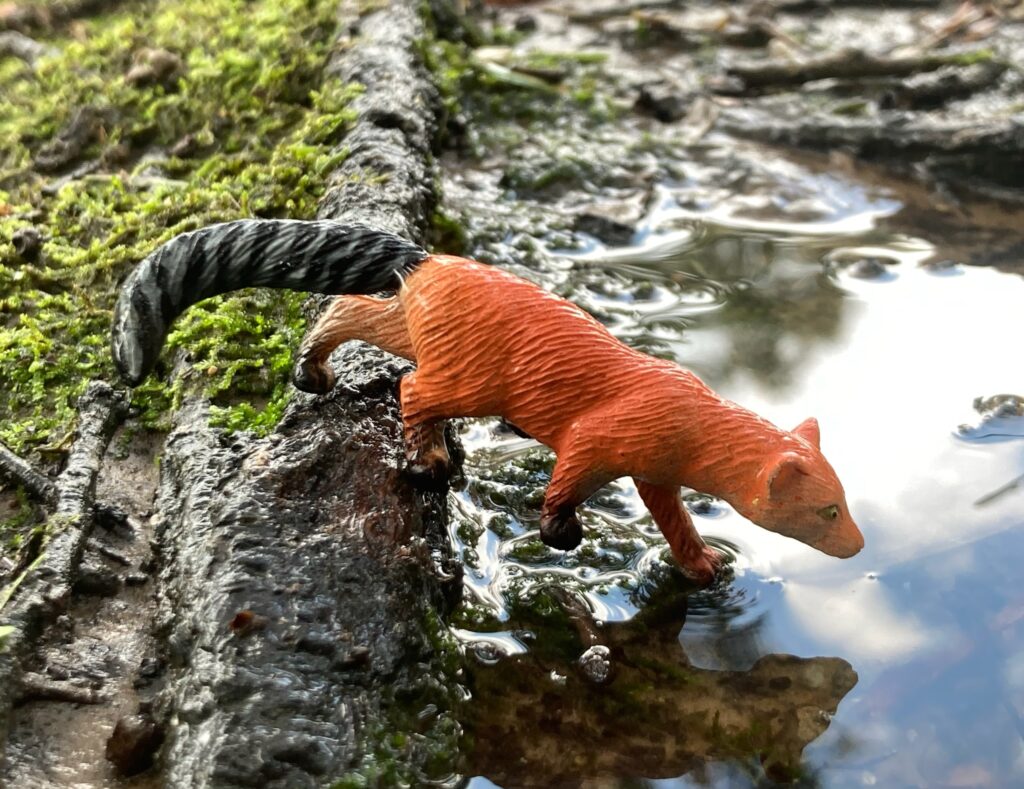
The sixth figure is the Ring-tailed Vontsira (Galidia elegans) of Madagascar. Formerly known as the Ring-tailed Mongoose (the name applied to this figure), the Ring-tailed Vontsira—along with the other Malagasy carnivorans—is currently classified in the family Eupleridae, and is the most widespread member of this family. G. elegans is a small and particularly agile omnivore noted for its webbed feet and of course its boldly striped tail. While the prototype color scheme—dark reddish with a dull brown head and black feet—would have been preferable, the orangish brown is fine enough, and the banding of the tail looks pretty good. The running pose of this figure is quite appropriate for this figure and separates it from the others in this set. Though this PV model is unique as a figure, two plush replicas of this species have been made: one by Hansa and the other for the Discovery Kids brand. In terms of scale, this figure is between 1:7 and 1:9.
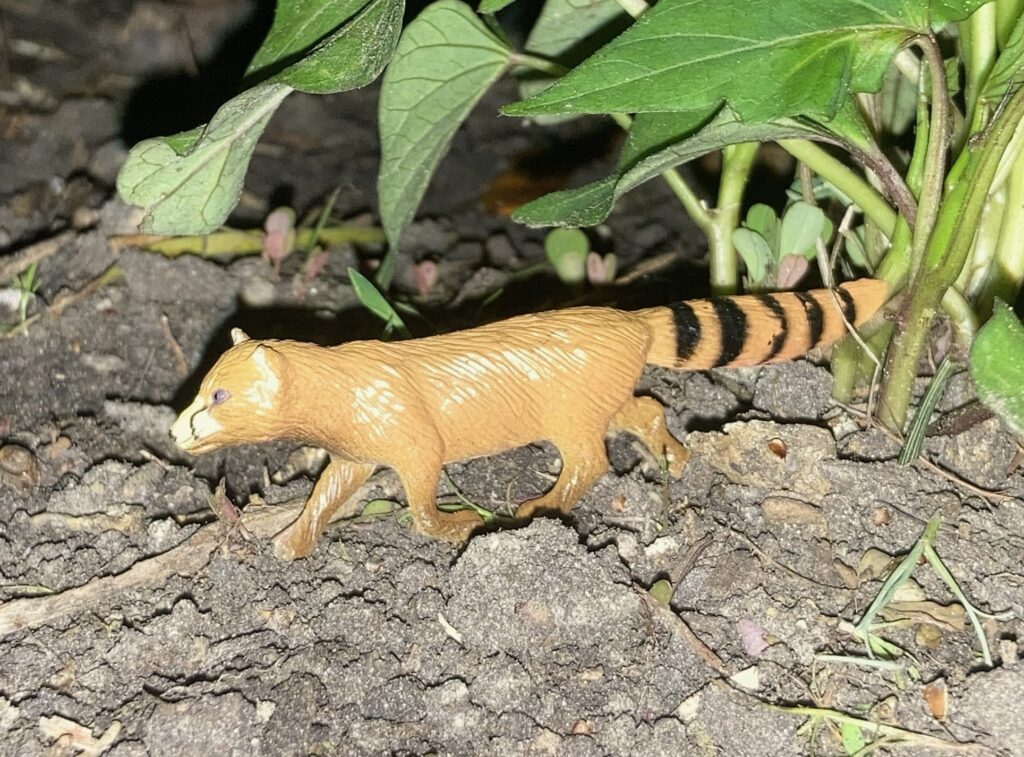
The seventh figure is marked BINTURONG, but doesn’t resemble Arctictis binturong in the slightest. The Binturong is an unusual civet distinguished by its long black fur, tufted ears, and prehensile tail. This figure, which is short-haired and mostly light in color with spots, is generally identified by collectors as the Common or Asian Palm Civet (Paradoxurus hermaphroditus). This nocturnal omnivore is found throughout southern Asia from India to South China to the Sunda Islands—where it is fed coffee-cherries and kept for its feces, which are made into kopi luwak, the most expensive coffee in the world. This figure is one of the weaker ones in the set in terms of accuracy: the legs, tail, and spot pattern should probably be black; the black mask does not cover the eyes as it should, the snout could be shorter, and the spots more subtle. Design-wise, there was probably some confusion as to what exactly this figure was supposed to be. Still, it’s a fair effort. The pose is definitely unique and the strongest point of this figure. If this is in fact P. hermaphroditus, this figure would be between 1:11 and 1:13 scale.
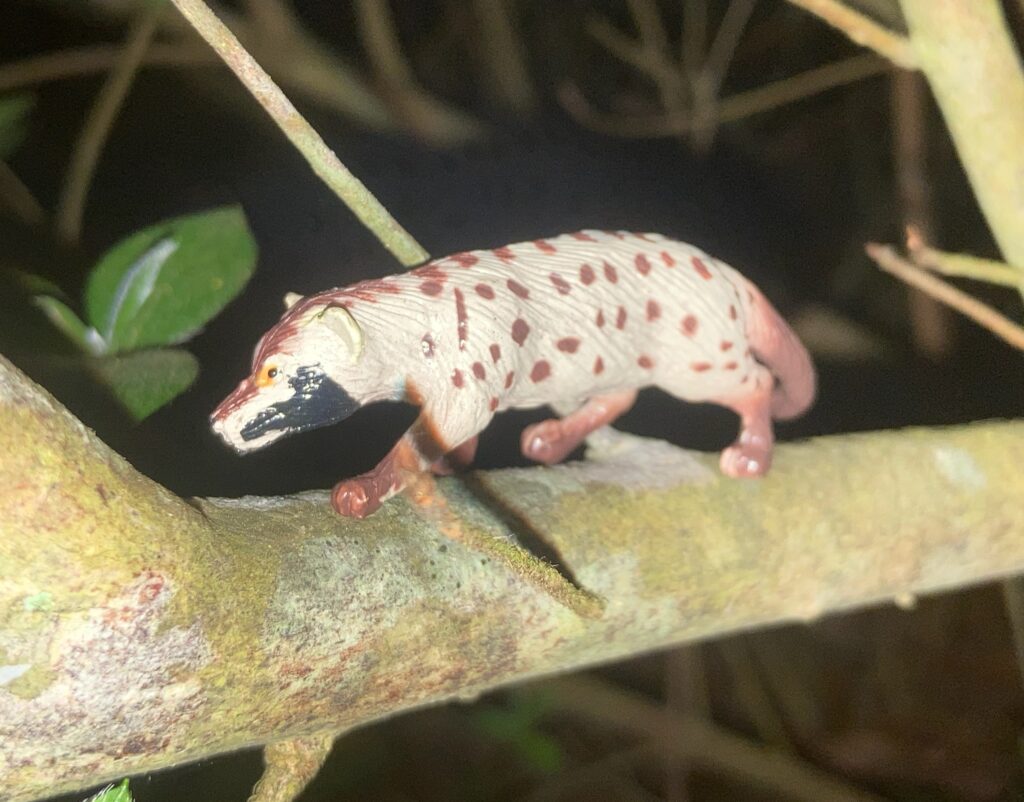
The eighth and final figure of the set is a somewhat perplexing one. It’s marked “GRAY MEERKAT”, an older name for what is now generally known as Selous’s Mongoose (Paracynictis selousi), an obscure species of true mongoose (Herpestidae) from Southern African scrublands. However, the sculpt of this figure—longer legs, shorter fur, small ears, slender pointed tail—strongly suggests it is based on the true Meerkat (Suricata suricatta), a smaller mongoose also from southern Africa but from more arid habitats. The upright pose is also popularly associated with S. suricatta, though all mongooses can assume this position. The color scheme doesn’t quite match either species: this figure lacks both the black legs of P. selousi and the dark facial markings and back stripes of S. suricatta. Funnily enough, the tail-tip of my figure is lighter on its right side (like the former) and darker on its left side (like the latter). Since it was most likely intended to represent S. suricatta, that’s what I’ll call it for the purposes of this review. The common Meerkat is one of the most popular small carnivores, and since it has been made so many times in both plush and plastic, I can’t really recommend this subpar figure, which is roughly 1:5 scale in case you were wondering.
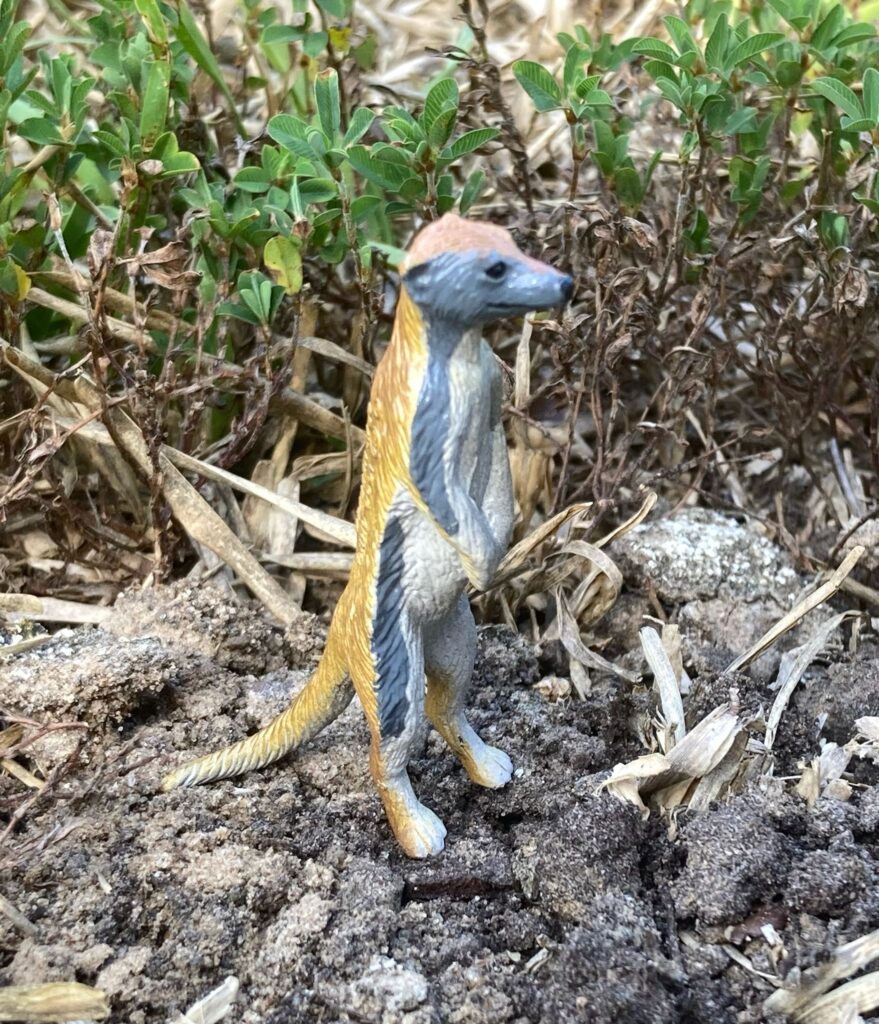
Overall, this is definitely a special series that, while not entirely perfect, includes some definite must-haves for any collector of African and Asian animals or obscure mammal species. As with the other Habitat: Earth figures, these were sold either in tube sets or in bulk, and have been discontinued for over 20 years. Fortunately, Collectible Wildlife Gifts still has pretty high quantities of all of these figures in stock, something that unfortunately can’t be said for most Play Visions figures. Still, it’s advisable to get the better ones while you can.

Disclaimer: links to Ebay and Amazon on the AnimalToyBlog are affiliate links, so we make a small commission if you use them. Thanks for supporting us!




What a remarkable array of carnivorans! I was not aware of the diversity within the civet/genet family.